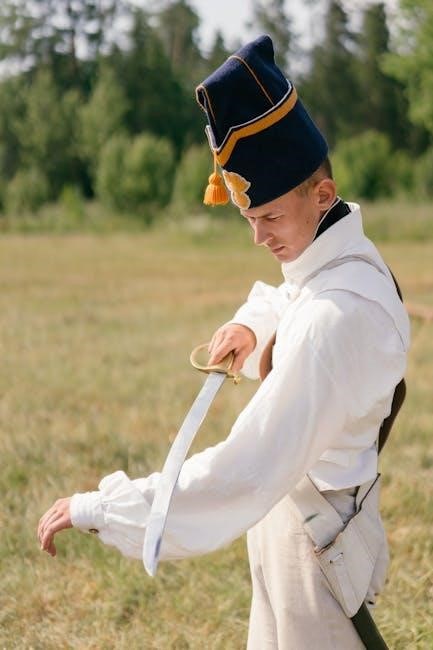Identifying Civil War swords involves understanding historical context, key characteristics, and manufacturer details. This guide helps enthusiasts authenticate and date swords from the American Civil War era accurately.
Understanding the Importance of Historical Context
Historical context is vital for accurately identifying Civil War swords. It helps determine authenticity by linking swords to specific events, units, or manufacturers. For instance, swords used in battles like Gettysburg or Shiloh often bear unique markings or wear patterns reflecting their combat history. Understanding the timeline of the Civil War and its key events aids in distinguishing genuine artifacts from reproductions. This context also reveals the evolution of sword designs and their role in military tactics, making it indispensable for collectors and historians alike.
Key Characteristics of Civil War Swords
Civil War swords are distinguished by specific features such as blade shape, hilt design, and metal composition. Common types include the Model 1850 and 1860 cavalry swords, which have curved blades and brass hilts. Infantry swords often featured straight blades and simpler designs. The presence of maker’s marks, military insignia, and engravings can also indicate authenticity and historical significance. These characteristics help collectors and historians differentiate between various models and verify the legitimacy of Civil War-era weapons.

Historical Background of Civil War Swords
Civil War swords were essential weapons during the American Civil War, reflecting technological advancements and military traditions. Their design and use evolved significantly during this period, shaping their historical significance and role in combat.
Evolution of Sword Design During the Civil War
The Civil War saw significant advancements in sword design, influenced by evolving battlefield tactics and European military traditions. Early war swords often mimicked older patterns, while later designs incorporated improved materials and ergonomic features. Cavalry swords became more curved for slashing, while infantry swords remained straight for thrusting. The development of saber designs and the introduction of new manufacturing techniques reflected the period’s shifting military needs and technological progress.
Major Battles and Their Impact on Sword Usage
Major battles like Gettysburg, Shiloh, and Chancellorsville highlighted the evolving role of swords in combat. The intensity of these conflicts often led to heavy wear on blades, while the need for versatility in tactics influenced sword design preferences. For instance, cavalry swords saw extensive use in charges, while infantry swords were often reserved for close-quarters fighting. These battles also revealed the limitations of traditional sword designs, pushing manufacturers to adapt to modern warfare demands.

Types of Civil War Swords
Civil War swords include cavalry, infantry, and officer swords, each with distinct designs. Cavalry swords, like the M1850 and M1860, were curved for slashing, while infantry swords, such as the M1840 and M1855, featured straight blades. Officer swords often had custom engravings and intricate designs, reflecting their status and regimental affiliations.
Cavalry Swords: M1850 and M1860 Models
The M1850 and M1860 cavalry swords were prominent during the Civil War, designed for slashing. The M1850 featured a curved blade, while the M1860 had a straight blade, influenced by European sabers. Both models had sturdy hilts, often with brass guards, and leather-wrapped grips. Manufactured by companies like Ames and Tiffany, they were issued to Union cavalry. The M1850 was heavier, while the M1860 was lighter, with a breakaway scabbard design. These swords symbolized the evolving nature of cavalry warfare during the conflict, blending practicality with historical design elements;
Infantry Swords: M1840 and M1855 Models
The M1840 and M1855 infantry swords were essential for Civil War foot soldiers. The M1840 featured a straight, single-edged blade with a wrought-iron hilt, while the M1855 introduced a rifled blade for thrusting. Both models had leather-wrapped grips and brass or iron guards. Manufactured by companies like Ames, they were designed for close combat. The M1855, influenced by European designs, had an elliptical guard, distinguishing it from earlier models. These swords were issued to Union infantry, reflecting the evolving tactics of ground warfare during the Civil War.
Officer Swords: Custom and Regimental Designs
Officer swords from the Civil War often featured custom and regimental designs, reflecting personal taste and unit identity. Many were ornately decorated with engravings, etchings, or inscriptions. High-ranking officers frequently commissioned unique pieces with intricate hilts, often made of brass or silver. These swords were symbols of authority and prestige, with designs varying by regiment or branch. Manufactured by renowned makers like Tiffany & Co. and Ames, they combined functionality with artistic craftsmanship, making them highly sought after by collectors today.
Manufacturer Marks and Inscriptions
Manufacturer marks and inscriptions are crucial for identifying Civil War swords. They often include the maker’s name, date, or regimental affiliations, aiding in authentication and historical tracing.
Identifying Maker’s Marks and Stamps
Makers’ marks and stamps are essential for tracing a sword’s origin. These marks, often found on the blade or hilt, reveal the manufacturer’s identity and production date. During the Civil War, prominent manufacturers like Ames and Tiffany & Co. stamped their names or initials, while others used symbols or codes. Some marks are faded or illegible due to age, requiring expert examination. Authenticating these marks ensures the sword’s legitimacy and historical accuracy.
Deciphering Historical Inscriptions and Engravings
Historical inscriptions and engravings on Civil War swords offer valuable insights into their history. Often found on the blade or hilt, these markings may include dedications, names, regimental insignias, or battle honors. Engravings can indicate ownership or commemorate significant events. Experts use these details to trace a sword’s lineage and verify its authenticity. Over time, wear and corrosion may obscure engravings, requiring specialized techniques to decipher; These inscriptions add layers of historical significance, making each sword a unique artifact of the Civil War era.
Blade Characteristics
Civil War swords feature distinctive blade shapes, sizes, and edge types. The condition and design of the blade, including fullers and ricasso, are crucial for identification and dating.
Understanding Blade Shapes and Sizes
Civil War swords exhibit a variety of blade shapes and sizes, reflecting their intended use. Cavalry swords often feature curved, single-edged blades for slashing, while infantry swords are straight and double-edged for thrusting. The M1850 and M1860 cavalry swords have distinctive curved blades, typically measuring 35-36 inches, with a clipped point. Infantry swords, like the M1840 and M1855, have straight blades ranging from 26-32 inches, designed for close combat. Officer swords often have more ornate blades, sometimes engraved, with varying lengths and shapes. The blade’s shape and size are critical for identifying its type and historical context.
Analyzing Edge Types and Condition
The edge type and condition of a Civil War sword provide crucial clues for identification. Cavalry swords typically have a sharp, single-edged blade designed for slashing, while infantry swords often feature a double-edged design for both cutting and thrusting. The condition of the edge, including nicks, wear, and patina, can indicate the sword’s usage and age. Swords with intact, well-defined edges are rare and highly valued, as many were heavily used in battle. The edge’s condition also helps determine the sword’s authenticity and historical significance.
Hilt and Guard Details
The hilt and guard are essential for identifying Civil War swords, revealing craftsmanship and officer rank. Their designs often signify regimental affiliation or military branch.
Recognizing Hilt Materials and Designs
Civil War sword hilts were typically made of brass, steel, or leather, with designs varying by rank and function. Officers often had intricately engraved or custom designs, while enlisted men’s swords featured simpler, more functional hilts. The materials and craftsmanship can indicate the sword’s origin and purpose. Brass hilts were common for officers, while steel was often used for cavalry swords. Leather-wrapped grips were typical for infantry swords, providing a secure hold during combat. Regimental markings or insignia on the hilt can help identify the unit or branch of service.
Guard Types and Their Significance
Civil War swords often featured distinctive guard types that served both functional and decorative purposes. The three-ring guard was common on cavalry swords, providing hand protection during heavy combat. Infantry swords often had a simpler, single-ring or kidney-shaped guard for lighter use. Guards were typically made of brass or steel and sometimes adorned with regimental insignia. The design and materials of the guard can help identify the sword’s intended use and historical context, making it a key element in authentication and identification.
Scabbard and Mountings
Scabbards were typically made of leather or metal, with mountings like throat, ring, and drag designs. These components, often decorative, provided functionality and historical significance, aiding identification.
Scabbard Materials and Construction
Civil War scabbards were primarily crafted from leather or metal, with leather being more common for cavalry swords. Metal scabbards, often brass or steel, were durable but heavier. Leather scabbards were typically made from thick, sturdy hides, stitched or riveted together for strength. Metal scabbards featured intricate mounting hardware, such as brass or steel throats and rings. Both materials were finished with protective coatings or decorative elements, reflecting the sword’s intended use and the owner’s status. Construction quality varied by manufacturer and purpose, aiding identification efforts.
Mounting Hardware and Decorative Elements
Civil War sword scabbards often featured mounting hardware such as brass or steel rings, throats, and drag plates. Decorative elements included engraved designs, patriotic motifs, and regimental insignia. These elements were typically added by the manufacturer or owner, offering insights into the sword’s history. The quality and design of hardware and decorations can help determine the sword’s authenticity, origin, and era, making them crucial for accurate identification and valuation.
Dating Your Civil War Sword
Dating Civil War swords involves examining historical records, manufacturer marks, and patina. This process helps determine the sword’s era and authenticity accurately.
Using Historical Records and Archives
Historical records and archives are crucial for dating Civil War swords. Military records, manufacturer ledgers, and archival databases provide insights into production timelines and issuance. By cross-referencing serial numbers, maker marks, and historical logs, researchers can pinpoint the era of a sword’s manufacture. Archival documents also reveal patterns of sword distribution among regiments, aiding in authenticating the weapon’s origins. This method ensures accuracy and connects the sword to its historical context effectively.
Examining Patina and Wear Patterns
Patina and wear patterns reveal a sword’s age and usage history. A genuine Civil War sword typically exhibits a natural patina from decades of exposure, while modern reproductions may lack this authenticity. Inspect the blade for consistent wear along the edge and near the hilt, indicating prolonged use. Scratches, rust spots, and handle wear further corroborate its historical legitimacy. These visual cues help differentiate between original and replicated pieces, aiding in accurate dating and authentication.
Collecting and Preserving Civil War Swords
Collecting Civil War swords requires careful preservation to maintain their historical integrity. Proper storage, cleaning, and handling ensure longevity, while ethical restoration preserves authenticity for future generations.
Best Practices for Maintenance and Storage
Proper maintenance ensures the longevity of Civil War swords. Regular cleaning with a soft cloth and mild soap prevents rust. Avoid harsh chemicals, as they can damage metal or erode patina. Store swords in a cool, dry environment to prevent moisture-related corrosion. Use a protective scabbard or display case to shield from dust. Avoid direct sunlight, as it can cause fading or warping of materials. Handle swords with care to preserve their historical integrity for future generations.
Restoration Ethics and Considerations
Restoring Civil War swords requires careful ethical consideration to preserve historical authenticity. Minimal intervention is recommended to maintain original patina and wear, as these traits hold significant historical value. Avoid over-restoration, as it can erase evidence of the sword’s past. Use reversible methods to ensure future preservation options remain intact. Consulting a professional conservator is advisable to balance aesthetics with historical integrity. Restoration should aim to stabilize, not alter, the sword’s condition, respecting its role as a tangible link to history.
Determining the Value of Your Sword
Sword value depends on rarity, condition, historical significance, and provenance. Expert appraisals and market research are essential for accurate valuation.
Factors Influencing Monetary Value
The monetary value of Civil War swords is influenced by rarity, condition, historical provenance, and maker’s marks. Swords with documented battlefield use or ties to notable officers command higher prices. The presence of original scabbards and intact hilts also enhances value. Additionally, the demand among collectors and the overall market trends play significant roles in determining the sword’s worth. Rare models, such as presentation swords, often fetch premium prices at auctions.
Appraisal Methods and Expert Consultation
Accurate appraisals of Civil War swords require professional evaluation by historians or antique weapons experts. Methods include examining historical records, maker’s marks, and condition. Experts assess rarity, provenance, and battlefield authenticity to determine value. Consulting reputable dealers or museums ensures accurate appraisals. Collectors should seek multiple opinions to confirm authenticity and market value, as misidentification can significantly impact a sword’s worth. Professional consultation is essential for obtaining reliable and trustworthy appraisals.

Common Misconceptions
Many believe all Civil War swords are rare or valuable, yet most are reproductions. Design differences often signify replicas rather than authentic battlefield weapons, requiring expert verification.
Debunking Myths About Civil War Swords
A common myth is that all Civil War swords are rare and valuable. However, many are reproductions or common models. Another misconception is that all swords were used in battles, while some were ceremonial. Additionally, the belief that every sword has a historical story is overstated. Experts emphasize the importance of verifying authenticity through historical records and physical examinations to separate fact from fiction.
Separating Fact from Fiction
Many Civil War swords are often mistaken for being battle-worn, but few actually saw combat. While some swords are genuine artifacts, others are reproductions or ceremonial pieces. Historical records and provenance are crucial for verifying authenticity. Experts rely on maker’s marks, blade characteristics, and historical documentation to distinguish genuine swords from modern replicas. Advanced techniques, such as metallurgical analysis, can also reveal a sword’s true origins. Always consult reputable sources and specialists to ensure accuracy in identification and valuation.

Resources for Further Study
Recommended books and online archives provide detailed insights into Civil War sword history, aiding collectors and researchers in deeper exploration and authentication of historical weapons.
Recommended Books and Online Archives
Notable books include Civil War Swords: A Reference Guide and The Sword in the Union: Civil War Sword Identification. Online archives like Google Books and HathiTrust offer digitized manuscripts. Museum websites, such as the National Park Service’s Civil War collection, provide detailed sword catalogs. Additionally, historical societies and forums dedicated to Civil War artifacts share valuable insights and images, aiding researchers in authenticating and understanding these historical weapons.
Museums and Collections to Visit
Visit the National Park Service Civil War sites, which showcase authentic swords in historical context. The Smithsonian National Museum of American History and the American Civil War Museum in Richmond, Virginia, house extensive collections. The U.S. Army War College Museum also features notable sword exhibits. These institutions provide hands-on access to artifacts, aiding researchers in studying designs, materials, and historical significance. Many museums offer digital archives and interactive exhibits for remote exploration.
Civil War sword identification requires meticulous study of historical context, design details, and manufacturer marks. This guide provides a foundation for enthusiasts to pursue further research and exploration.
Summarizing Key Identification Points
Civil War sword identification hinges on understanding historical context, blade characteristics, hilt designs, and manufacturer marks. Key points include distinguishing cavalry from infantry swords, recognizing officer swords’ custom designs, and analyzing scabbard materials. Historical records and patina can aid in dating, while maker’s marks provide clues about origin. Expert consultation and detailed research are crucial for accurate identification and valuation, ensuring preservation of these historical artifacts for future generations.
Encouragement for Further Research
Further research is essential for deepening your understanding of Civil War swords. Explore recommended books, online archives, and museum collections to gain insights. Engage with historical societies and collector communities to learn from experts. Attend workshops and seminars to refine your identification skills. Remember, uncovering the history behind each sword is a rewarding journey that connects us to the past. Keep exploring and expanding your knowledge to become a skilled collector and historian.